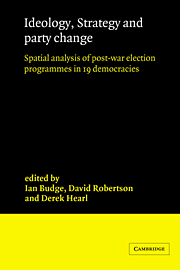 Ideology, Strategy and Party Change
Ideology, Strategy and Party Change Published online by Cambridge University Press: 27 October 2009
INTRODUCTION
The 1983 legislative elections aggravated Italy's crisis of governability. The Christian Democrats who as the largest party had dominated successive post-war governments, suffered a startling decline in support. Yet, this was not sufficient to produce a major change within the political system. The parties that gained most from Christian Democrat decline were their traditional coalition partners, the small centre parties. This was sufficient to gain a Socialist the premiership, but not to turn a Socialist-led ‘third force’ into a credible alternative to Catholicism or Communism. Of the opposition forces, the Communists, long excluded from government (save on a marginal basis in 1978–9), managed to hold their levels of support constant. But they are no nearer than before to participation in government. The neo-fascists (Italian Social Movement) increased their vote drastically. However, they are so marginalized within the political system that this is nowhere near large enough to alter the balance of power. Thus, the centre-left coalition continues as the most likely pattern until the next elections. Arid the political system continues to face a stalemate.
The basic absence of change should not obscure the fact that party votes during the 1970s and 1980s have been more variable than in earlier years. Why? In the past votes were determined by custom or clientelistic systems. Certain regions, such as the North-East and the Centre have become closely identified with Catholic and Socialist/Communist support respectively. In the South, clientelism has been a more important determinant.
To save this book to your Kindle, first ensure no-reply@cambridge.org is added to your Approved Personal Document E-mail List under your Personal Document Settings on the Manage Your Content and Devices page of your Amazon account. Then enter the ‘name’ part of your Kindle email address below. Find out more about saving to your Kindle.
Note you can select to save to either the @free.kindle.com or @kindle.com variations. ‘@free.kindle.com’ emails are free but can only be saved to your device when it is connected to wi-fi. ‘@kindle.com’ emails can be delivered even when you are not connected to wi-fi, but note that service fees apply.
Find out more about the Kindle Personal Document Service.
To save content items to your account, please confirm that you agree to abide by our usage policies. If this is the first time you use this feature, you will be asked to authorise Cambridge Core to connect with your account. Find out more about saving content to Dropbox.
To save content items to your account, please confirm that you agree to abide by our usage policies. If this is the first time you use this feature, you will be asked to authorise Cambridge Core to connect with your account. Find out more about saving content to Google Drive.